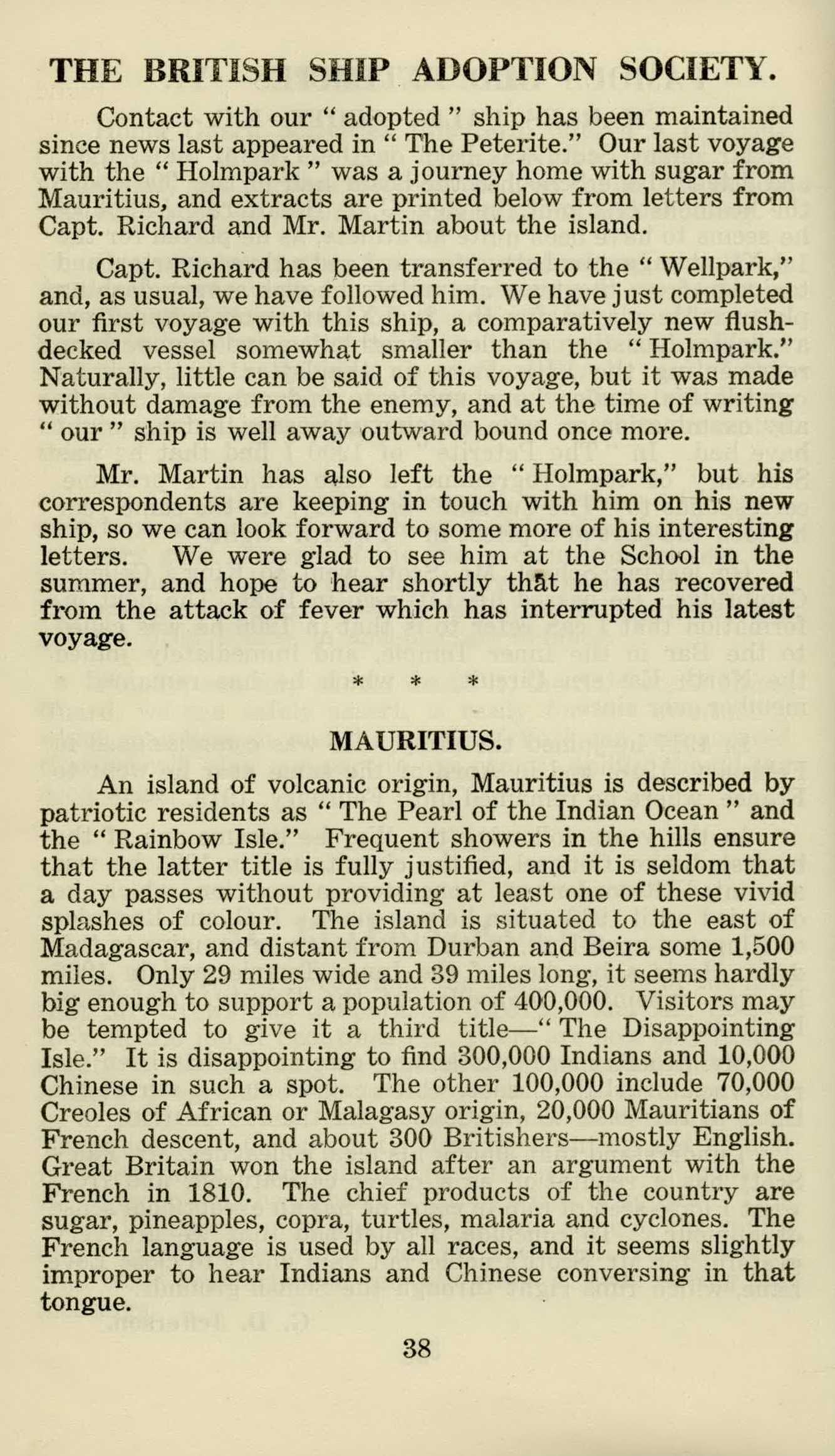
10 minute read
The British Ship Adoption Society
from Jan 1941
by StPetersYork
Contact with our " adopted " ship has been maintained since news last appeared in " The Peterite." Our last voyage with the " Holmpark " was a journey home with sugar from Mauritius, and extracts are printed below from letters from Capt. Richard and Mr. Martin about the island.
Capt. Richard has been transferred to the " Wellpark," and, as usual, we have followed him. We have just completed our first voyage with this ship, a comparatively new flushdecked vessel somewhat smaller than the " Holmpark." Naturally, little can be said of this voyage, but it was made without damage from the enemy, and at the time of writing " our " ship is well away outward bound once more.
Mr. Martin has also left the " Holmpark," but his correspondents are keeping in touch with him on his new ship, so we can look forward to some more of his interesting letters. We were glad to see him at the School in the summer, and hope to hear shortly that he has recovered from the attack of fever which has interrupted his latest voyage.
MAURITIUS.
An island of volcanic origin, Mauritius is described by patriotic residents as " The Pearl of the Indian Ocean " and the " Rainbow Isle." Frequent showers in the hills ensure that the latter title is fully justified, and it is seldom that a day passes without providing at least one of these vivid splashes of colour. The island is situated to the east of Madagascar, and distant from Durban and Beira some 1,500 miles. Only 29 miles wide and 39 miles long, it seems hardly big enough to support a population of 400,000. Visitors may be tempted to give it a third title—" The Disappointing Isle." It is disappointing to find 300,000 Indians and 10,000 Chinese in such a spot. The other 100,000 include 70,000 Creoles of African or Malagasy origin, 20,000 Mauritians of French descent, and about 300 Britishers—mostly English. Great Britain won the island after an argument with the French in 1810. The chief products of the country are sugar, pineapples, copra, turtles, malaria and cyclones. The French language is used by all races, and it seems slightly improper to hear Indians and Chinese conversing in that tongue.
Numerous rivers provide good fishing, while the sea offers plenty of thrills for big-game fishermen. All round the coast there is ample opportunity to catch tunny, becune, barracuda, sailfish and Marline swordfish. Fresh and salt water both entice swimmers, and nature has arranged excellent protection against sharks. Lagoons surrounded by coral reefs keep these hungry pests away—the reefs keep them outside the lagoons. One of the best lagoons is Blue Bay. It is the crater of an extinct volcano, and the water is very deep, and even among bright blue lagoons this one stands out by the vividness of its colour. Residents are proud of the fact that this stretch of water inspired the title of de Vere Stacpoole's novel, " The Blue Lagoon.", The coast is well sprinkled with old Dutch forts (they had a finger in the pie at one time) and numerous French fortifications, which were used as protection from revengeful Corsairs who had been driven out during the 18th century. The latter earned an honest crust by raiding the East India fleet of merchantmen as they passed to and from Europe via the Cape of Good Hope.
From November to May cyclones are to be expected, but there is usually 24 to 48 hours' notice, due to sudden big drops in barometric pressure, and the " feel " of the atmosphere. Shipping takes full advantage of the warning and leaves the harbours for the open sea, while people on shore take in the family washing and prepare generally for a spot of bother. In 1931 the bridge over the river at Baie du Cap was lifted by the wind and scattered over the countryside some miles away. Malarial mosquitoes are most active during this period, and it is advisable not to remain at the seaside after sunset during these months.
Port Louis is the only harbour in use to-day, except for small craft. The town is rather a ramshackle place and the buildings are very much in need of paint. It is a typical " native " town, although there are two or three beautiful avenues. They remain beautiful in spite of neglect. A noticeable feature of the town are the gutters in the streets, and more particularly the storm water canals which wander from the foot of the mountains to the harbour. The gutters are wide and deep in order to cope with the large volume of water which has to be carried away during every tropical shower. Past experience must be responsible for the construction of the storm water canals. They are about 50 ft. wide and 20 ft. deep and built of brick. So great is the volume of water which rushes down from the mountains
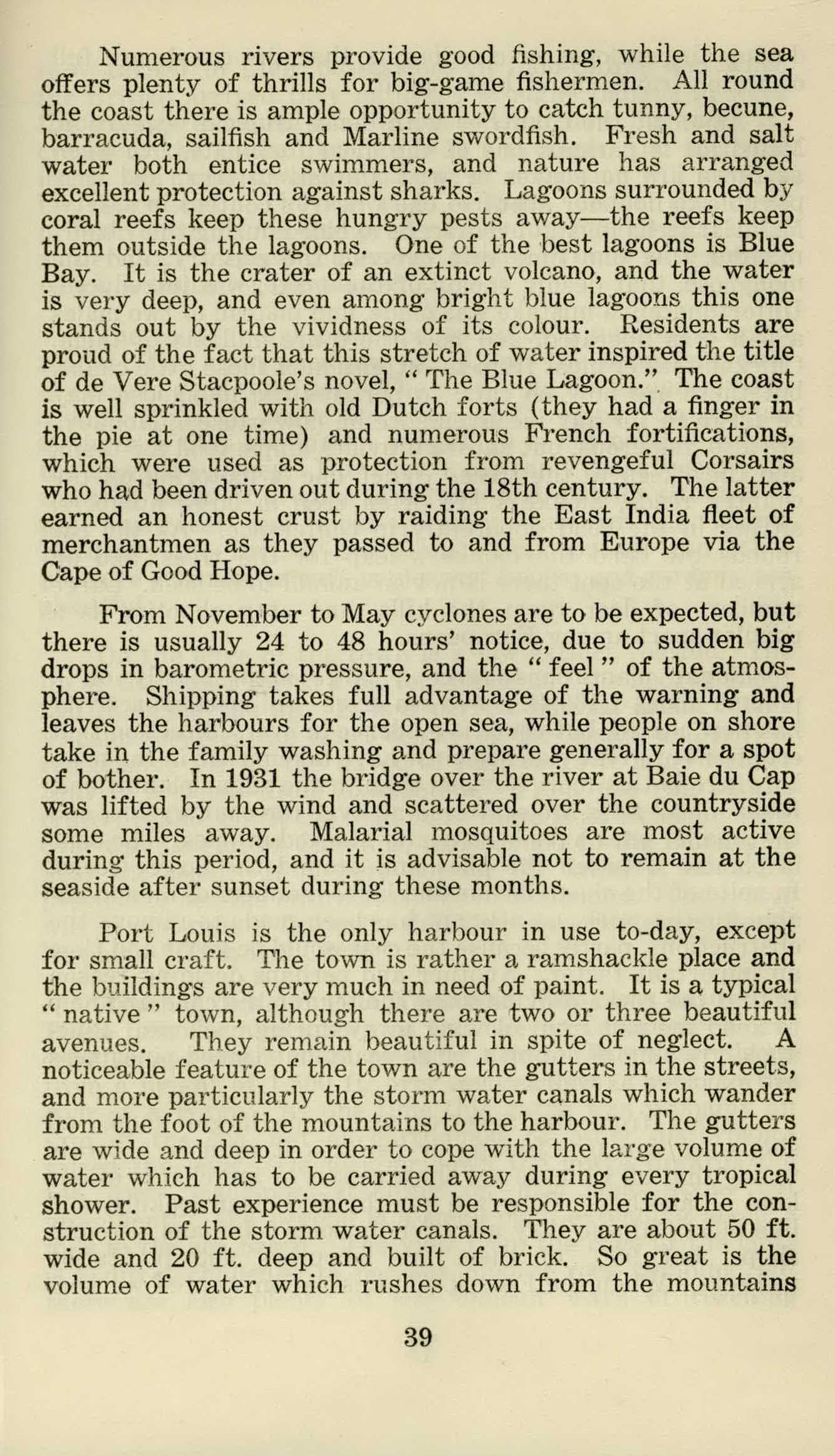
39
during the cyclones or cloudbursts that the canals are full of water travelling at high speed.
Amongst the countries with dense tropical vegetation, Mauritius is perhaps one of the most fortunate, inasmuch as there are no snakes or wild animals to fear, and it is possible to flounder about to one's heart's content in safety. Malarial areas must, of course, be avoided during the " bad " months. At one time rats overran the country, and the mongoose, that deadly enemy of the snake, was introducel. Unfortunately a mistake was made, and instead of two malesa pair was liberated, and now there are millions of them. Chickens suffer most from the attention of these little chaps, but there are now no rats, so perhaps the mongoose may be forgiven for any inconvenience he now causes. Monkeys are also numerous, but nature provides ample food for them, and they keep to the trees. When one is motoring on the country roads, monkeys are often seen in large numbers, sitting in the road apparently in conference. As the car rounds the bend the monkeys leap for the trees, and on arrival at the spot there is not an animal to be seen. Large numbers of deer roam the hills, and stag shooting is a popular sport among Europeans.
Sugar plantations cover a large area, mostly on a plateau about 1,100 ft. above sea level. All volcanic activity has now ceased, but there is evidence in every direction that eruptions of great violence must have taken place in the past. Nowhere is this more obvious than in the sugar plantations. Rocks of all sizes are scattered all over the countryside, and the smaller ones have been neatly stacked in piles. The cane is planted between the piles and around the larger rocks. In spite of the cheap labour and large numbers of men available for the work, no attempt has been made to remove the obstructions, partly because the cost would be great and time an important factor. Another and perhaps deciding reason is that the rocks provide some shelter for the cane and help to keep the soil from blowing away during cyclones. Pineapple growing is not on a large scale, but tinned pineapples are exported as well as jam.
Apart from the agencies and some larger shops, all shops are run by Chinese, or perhaps it is more accurate to say that all Chinese are shopkeepers or merchants of one kind or another. They are healthy and clean looking, and like most Chinese they are friendly souls. Indians also own shops, but 90% of them are labourers and plantation workers. When the French administration wanted workers
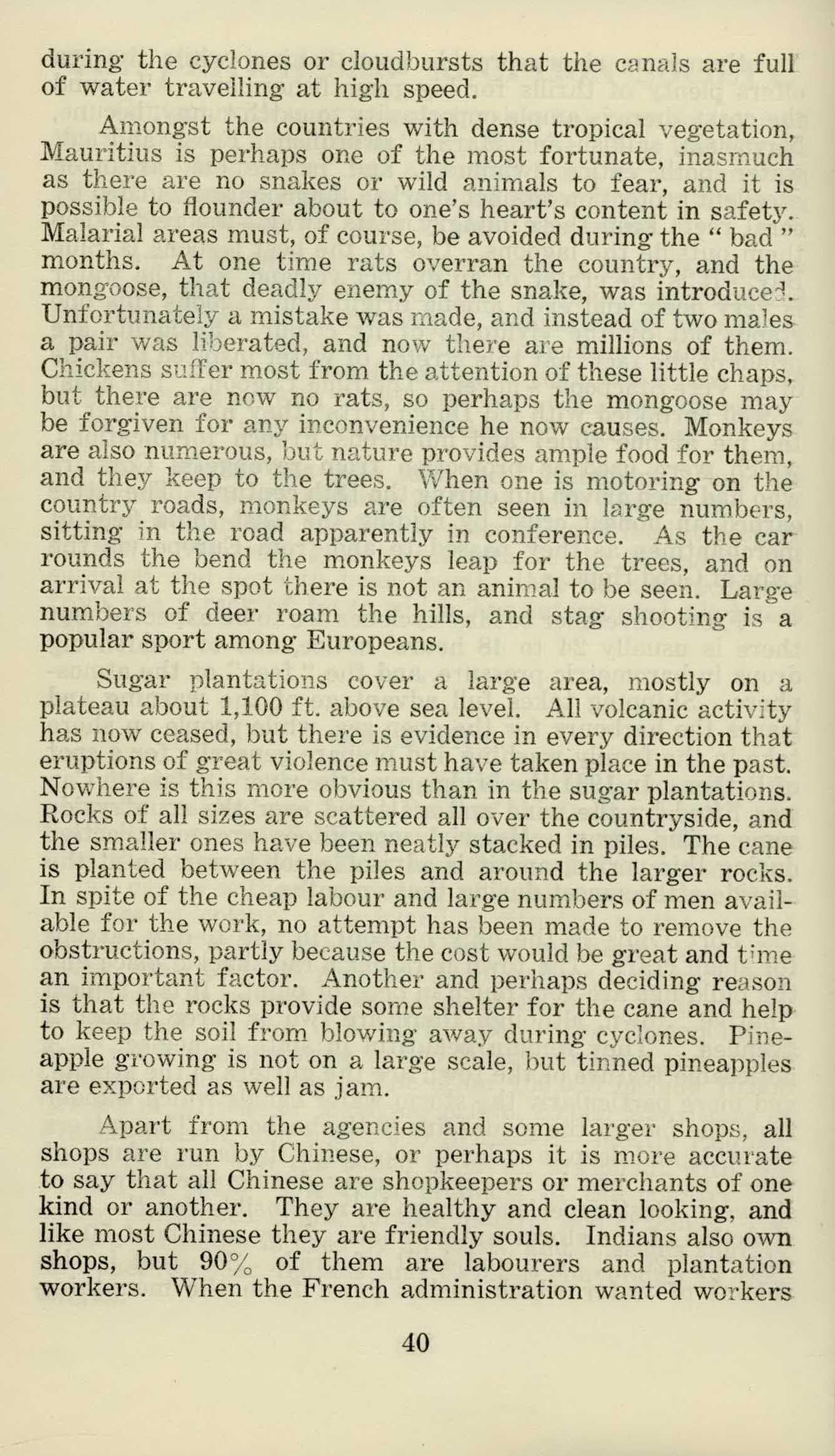
40
they turned to their possessions in Indo-China, and when the British arrived they naturally brought Indians to work the greatly extended plantations. Even now the rapid increase of the Indian population is a problem, and the time is not far distant when a scheme of migration will have to be introduced. They live in villages under the most primitive conditions, and prefer to live in squalid mud huts, rather than to spend the energy needed to build with timber which is there for the taking.
The country has been opened up by a number of good roads. The main ones are paved, but the secondary ones are also in good condition. The road from Port Louis rises to a point 1,500 ft. above sea level—at Curepipe. So gradual is the rise that the fifteen mile climb is not noticed during the upward journey. However, a car can " coast " nearly all the way back. Curepipe is a town and district situated in the healthiest and most pleasant part of the island. Naturally the British live there. Golf courses and other pleasure grounds, as well as pleasant houses and gardens, are plentiful.
On the edge of the town is a low extinct volcano. The lip of the crater forms a perfect circle and the floor is about 200 ft. below the lip. It is a perfect natural arena. This volcano occupies the exact centre of the island, and if it is responsible for all the havoc of past years it is no wonder that it is dead—from exhaustion. From the rim of the crater, round which the road runs, there is an excellent view over the district of Curepipe, and beyond to the mountains near the coast. If it were not for the latter it would be possible to see the entire coastline of the island. The crater was at one time a favourite drinking place for stags, hence its name, " Trou aux Cerfs."
Another day's run, to Tamarind Falls, was enjoyable. These falls are also known as the " Seven Cascades," a descriptive and much more pleasing name. The water drops from a height of 1,500 ft. over seven ledges of rock, to the floor of a gorge. At one time this gorge was probably an arm of the sea, but an earthquake or other disturbance raised the level. On looking down the gorge towards the sea, two headlands—standing on dry land—stand out prominently, and beyond is a small plain extending about a mile to the sea beach. The view from the edge of the cliffs is a direct challenge to persons fond of rock climbing, but there are also plenty of less difficult ways of reaching
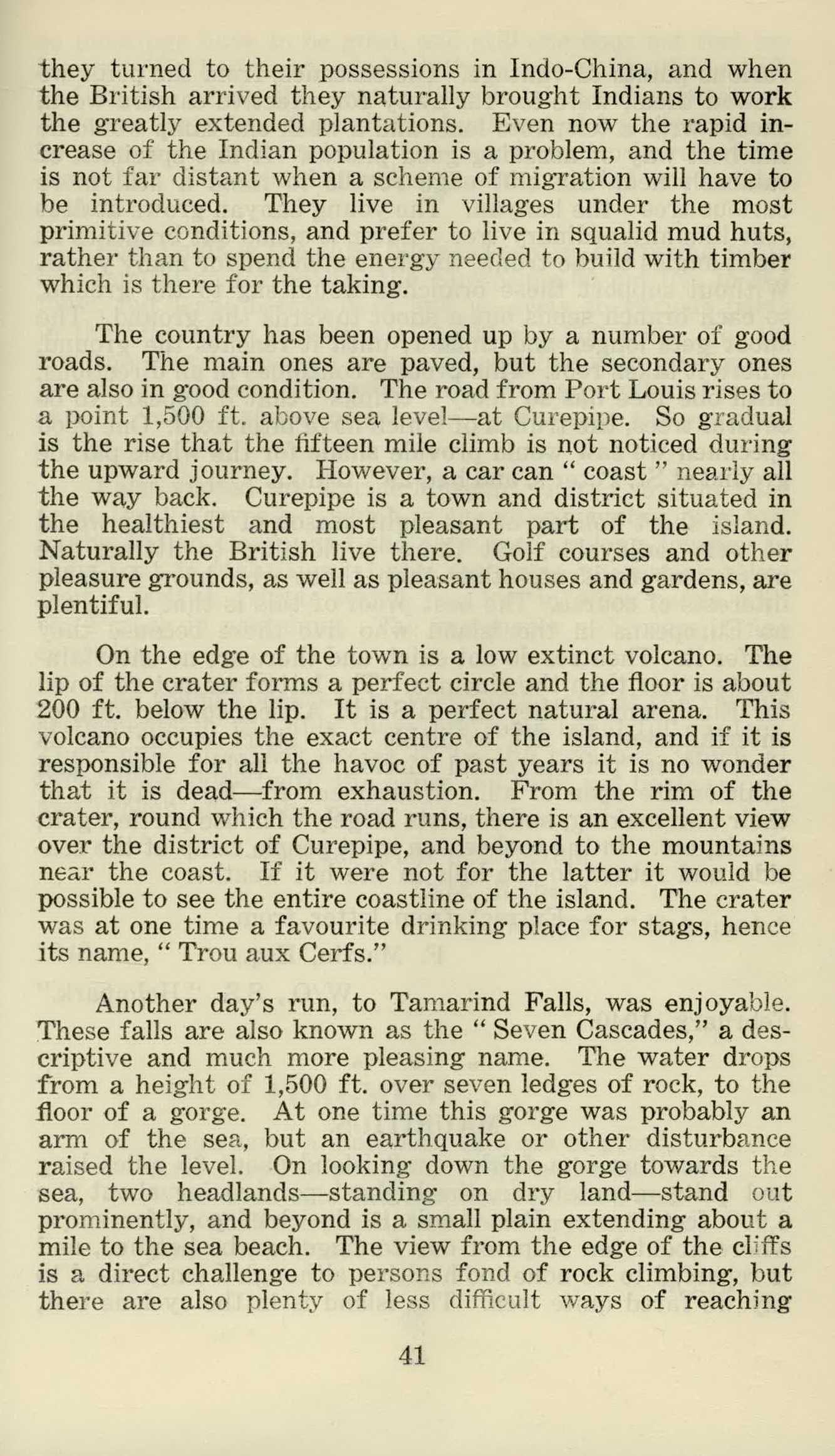
various points of vantage. The cascades, from the point we viewed them, were too far away for effective camera work, except with a telephoto lens, and a week-end camp would be the best way of assuring good photos. A fine specimen of calabash near the cliff edge recalls to mind a still more curious tree—the banyan. The young banyan grows at first just like any ordinary tree. Later it sends out branches at right angles to the trunk, which stretch out for many yards.. Without support these branches would sag to the ground, so each branch sends out a shoot towards the ground. The shoot gets longer and thicker, until it reaches the ground, where it takes root. This process continues in all directions, until one tree has so many " trunks " that it appears to be several trees, the trunks of which have interlaced. One good specimen we saw would provide shade for the whole parade ground at St. Peter's, and had 29 " trunks."
A short holiday at the right season of the year would be very enjoyable, but there is nothing to attract the permanent resident, other than those who have business interests of course. The best proof of this is that there are no Europeans in the island who live there because they prefer it. Theatres do not exist, and there are no entertainments other than the cinemas. The latter are not reserved for Europeans as they are in South Africa, so this form of entertainment is not available. A strict colour bar is observed in private social circles, but public places and vehicles are open to all. Amusement for Europeans is of their own making, and consists largely of house parties, golf, tennis, etc. In the cool season most people camp at the seaside, and return to the hills in the hot weather. —Extract from letter from F. Martin, Esq., W/O., S.S. " Holmpark."
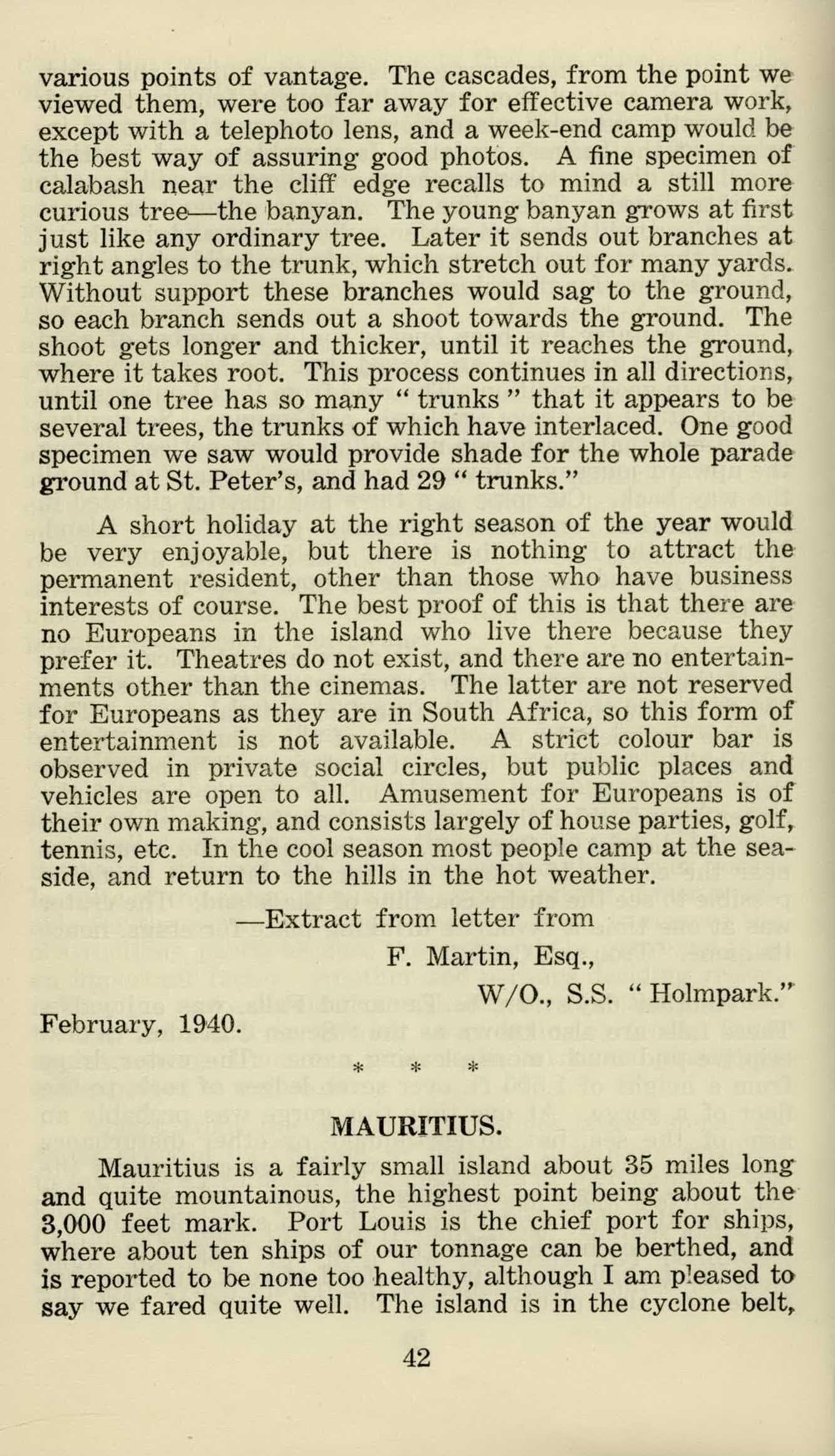
February, 1940.
MAURITIUS.
Mauritius is a fairly small island about 35 miles long and quite mountainous, the highest point being about the 3,000 feet mark. Port Louis is the chief port for ships, where about ten ships of our tonnage can be berthed, and is reported to be none too healthy, although I am pleased to say we fared quite well. The island is in the cyclone belt,










